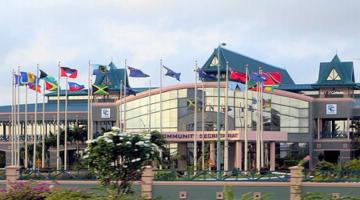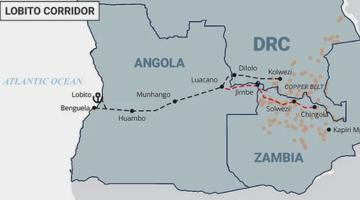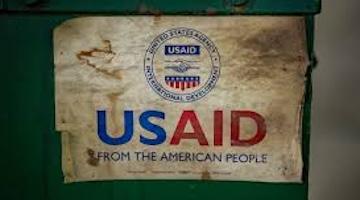The Board of Governors of International Monetary Fund in 1999 (Wikimedia Commons).
Presenting new research, Dylan Sullivan and Jason Hickel mount a devastating critique of the impact of structural adjustment in Africa in the 1980s and 1990s. Drawing on recent data on Africa’s material resource use, Sullivan and Hickel show how during this period structural adjustment programmes led to a significant increase in ‘unequal ecological exchange’, a process whereby African countries were compelled to export more materials, energy, and other resources than they received in imports. The difference between the two, Sullivan and Hickel argue, represented a transfer of real tangible materials from Africa to the capitalist world economy, for free.
Originally published in ROAPE .
During the 1980s and 1990s, the International Monetary Fund (IMF) and World Bank forced governments across Africa to implement neoliberal structural adjustment programmes (SAPs). SAPs compelled post-colonial governments to cut public services and public-sector production, remove labour market regulations and wage protections, privatize sovereign assets, and eliminate protectionist measures and industrial policy aimed at achieving sovereign industrial development.
These reforms dismantled the progressive policies that were then being pursued by African nationalists and socialists, who were seeking to build their industrial base and improve living standards following the catastrophe of European colonialism. Many African leaders and scholars – including Thomas Sankara and Samir Amin – emphasized that SAPs worked to re-impose the imperial relationship, by asserting Western control over national economic policy, cheapening African resources, and organizing production around exports to the imperial core in subordinate positions within global commodity chains.
It is well-known that SAPs had a devastating impact on the peoples of Africa. Between 1980 and 1994, Africa’s per capita GDP declined from around $4,500 to below $4,200 US dollars (2023 PPP). Incomes did not recover until 2001. In other words, SAPs imposed a recession that lasted for over two decades. Studies show that SAPs were associated with elevated child and maternal mortality rates , higher levels of poverty , and a deterioration in human development outcomes . In some cases, the crisis was so severe that it triggered a reduction in people’s physical stature, a sign of extreme nutritional stress and a breakdown in public health. For instance, people born in Tanzania in the 1980s were around a centimetre shorter than people born a decade – or even a century – earlier .
Recent data on Africa’s material resource use – i.e., the total quantity of material stuff (in tonnes) used by African economies – provides new insights into how this crisis played out (see Figure 1). ‘Domestic extraction’ (DE) per capita refers to the total quantity of raw materials extracted from the environment in Africa – in other words, all the biomass, metals, minerals, construction materials, and fossil fuels produced by Africa’s mines, farms, forests, fisheries, etc. DE represents a fairly robust indicator of physical production. We see that per capita DE declined by over 10% during the 1980s and 1990s, under structural adjustment. This strongly suggests that SAPs induced a recession, or decline in physical production, which is consistent with data showing declining GDP per capita during that period.
Crucially, however, Africa’s ‘material footprint’ (MF) per capita declined by substantially more than domestic extraction (Figure 1). MF refers to the total quantity of raw materials consumed in Africa, including those embodied in imported goods and excluding those embodied in exported goods. The MF data shows that African consumption declined by 20% from 1980 through the 1990s, and only recovered to its previous levels in 2013. The decline in African consumption was more severe than the decline in production.
Of course, a decline in material use can sometimes result from efficiency improvements, but this normally only occurs in developed economies with strong technological endowment, and is accompanied by rising GDP. This is not what occurred in Africa, where GDP declined at the same time. Indeed, African countries were not operating at the technological frontier where such efficiency improvements generally occur – a problem which was exacerbated by SAPs that slashed public investment in technological development.
The data indicates that, after 1980, Africans were producing less, but they were consuming even less than they produced. Where did the missing output go? It was exported to the rest of the world, and without an equivalent material return
Source: materialflows.net.
We can see this pattern when we look at the export data. Figure 2 shows African exports from 1980 to the early 2000s, measured both in dollar terms and in ‘raw material equivalents.’[1] Note that raw material equivalents include primary commodity exports as well as intermediate and final goods, and all materials embodied in their production. This data confirms that, while Africa’s material consumption was declining, material exports were increasing at a rapid pace. In other words, it appears that Africa’s productive capacity and material output was redirected away from regional needs toward exports. However, even while physical exports were increasing, there was a decline in the total amount of money that Africa received for them. While the physical and monetary values of exports increased in tandem during the 1970s, there was a dramatic break in the 1980s and the two diverged. This indicates that Africa’s export prices were crushed, such that Africa earned less per unit of export (see Table 1).
Source: materialflows.net and IMF trade statistics.
It is worth pausing here to appreciate the value of assessing trade in this way. Assessments of conventional trade data – i.e., measured in monetary terms – suggest that Africa’s exports declined in the 1980s. But Figure 2 and Table 1 demonstrate that this is an illusion: an effect of declining prices. In reality, Africa’s physical exports increased while earnings on exports declined. This data adds an important new piece to the story of structural adjustment.
SAPs crushed African prices in several ways. They eliminated export controls and other government programmes aimed at securing fair prices for African farmers and producers. They also eliminated labour protections and caused mass unemployment , putting downward pressure on wages and prices, all while restricting public spending and forcing governments to pursue deflationary fiscal policies. SAPs effectively compressed domestic demand , cheapening resources and making them available to the export sector – a process known as income deflation.
Source: materialflows.net and IMF trade statistics.
As a result of these dynamics, African countries were compelled to export more physical goods to maintain the same level of physical imports in raw material equivalents. We can see this pattern clearly in Figure 3. While Africa’s material exports increased by 55% during the 1980s and 1990s, its material imports remained virtually stagnant. The difference between the two represents a free gift to the capitalist world economy – a transfer of real tangible materials from Africa to the rest of the world, for free. In 1980, Africa was already net-exporting 720 million tonnes of embodied materials to the rest of the world. By the early 2000s, this had increased to 1.5 billion. Structural adjustment forced Africa to double its exports to the rest of the world, while receiving no equivalent return, and while domestic consumption collapsed.
Source: materialflows.net
These patterns help to explain why governments and capitalists in the Global North have been so eager to force SAPs onto Africa, despite the clear human costs. By reducing African consumption, crushing African prices, and reorganizing production around exports, SAPs led to a marked increase in ‘unequal ecological exchange ,’ a process whereby African countries are compelled to export more materials, energy, and other resources than they receive in imports. By suppressing African export prices relative to imports, SAPs worked to increase the outflow of materials. Imports stagnated while exports increased. Africa’s productive capacities and resources which could have been invested in sovereign industrialization and human development were instead cheapened and exported to service accumulation in the imperial core.
[1] We adjusted the dollar value of exports for inflation using the US consumer price index, obtained from the International Monetary Fund.
Dylan Sullivan is a PhD candidate under a cotutelle agreement between Macquarie University, Sydney, and the Autonomous University of Barcelona. His research focuses on global inequality, poverty measurement, political economy, and socialist planning.
Jason Hickel is a Professor at the Institute for Environmental Science and Technology (ICTA-UAB) at the Autonomous University of Barcelona, and Visiting Professor at the London School of Economics and Political Science. His research focuses on global inequality, imperialism, and international development. His most recent books are “The Divide: A brief guide to global inequality and its solutions”, and “Less is more: How degrowth will save the world”.



















